- Comparative Study of Shape Memory Alloy Reinforced Kevlar Polymer Composite in Sheet and Wire Form with Plain Kevlar Polymer Composite
R. Prabu†
 , K. M. Kumar*, R. Selvam*, and K. R. Vijaya Kumar**
, K. M. Kumar*, R. Selvam*, and K. R. Vijaya Kumar**School of Maritime Studies, Vels Institute of Science, Technology & Advanced Studies, 603103, India
*St. Joseph’s College of Engineering, 600119, India
**Dr. MGR Educational and Research Institute, 600095, India- 쉬트와 와이어 형태를 가진 형상기억합금 강화 케블라 고분자 복합체와 일반 케블라 고분자 복합체의 비교 연구
Reproduction, stored in a retrieval system, or transmitted in any form of any part of this publication is permitted only by written permission from the Polymer Society of Korea.
The main objective of this work is to investigate the effect of shape memory alloy reinforcement in Kevlar polymer composites on mechanical and low-velocity impact properties. The sheet and wire forms of shape memory alloy (SMA-nickel-titanium alloy) are used as potential reinforcements in Kevlar-reinforced polymer composite. The developed composites were analyzed for tensile and flexural behavior. The effective bonding area, referred to as core density, contributes to incremental flexural strength in the SMA sheet reinforced composites. The developed composites exhibited better impact resistance during low-velocity impact tests at different velocities, 2.80, 3.96, and 4.85 m/sec, and simulated using a CEAST drop hammer testing machine. The impact surface of the specimen was studied on a micro-level using SEM analysis and macro-level using Image J software. The impact force, the energy absorbed, and the deformation of the specimen during impact were recorded and analyzed. The experimental results reveal that the SMA sheet reinforced Kevlar composites exhibited appreciable impact resistance with maximum energy absorbing capacity comparatively with plain Kevlar and SMA wire reinforced composites
During the impact test, the [Kevlar/Kevlar/Kevlar] composite experienced river-like flow fracture mode as a failure mechanism along with fiber cracking during the impact.
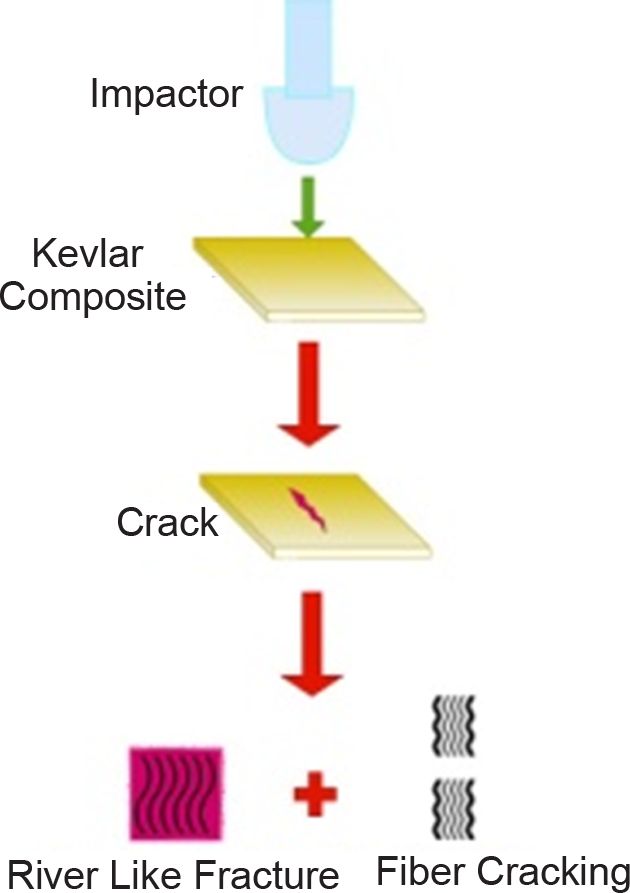
Keywords: low-velocity impact, shape memory alloy, Kevlar, better adhesion, fiber cracking, inter crystalline fracture
The author like to acknowledge Central Institute of Plastic Engineering and Technology, Chennai for granting permission to carry out Tensile and flexural test at their facility. Also like to acknowledge Department of Aerospace Engineering, Madras Institute of Technology Chennai for rendering support and granting permission for the Low Velocity Impact test facility at their premises.
Kevlar1-3 technically called Poly-para phenylene terephthalamide presented in Figure 1 is a heat-resistant light-weight strong fiber mainly used for ballistic armor applications in epoxy polymer composites. It is also used in various applications such as safety gloves for industries, ropes for handling heavy-weight applications, and low-velocity impact applications. The research on strengthening Kevlar composites to enhance impact resistance using metallic particulate reinforcements, sheet metal compounds, and different processing routes is extensively carried out. There is limited research on Kevlar composites reinforced with shape memory alloys (nickel-titanium alloy), and the effect of SMA (shape memory alloy) reinforcement on the low-velocity impact resistance of the composite materials. The high deformation resistance and shape-retaining property post removal of loading structure, which is the unique property of shape memory alloys, can be integrated with plain Kevlar composites. Also, SMAs withstand high energy deformation, thus potentially suitable for ballistic armor applications. The other applications of SMA include fire alarm, smart structures, cryo bolts used for rocket launching applications, and many more. The current research focuses on improving mechanical properties4-10 with less number of reinforcement layers. Although Kevlar is a tough material that suits armor applications the current research focuses on improving the tensile,11 flexural,12 impact13-22 resistance by reinforcing Kevlar epoxy polymer composites with Ni-Ti SMA in the form of wire and sheet.
Prasad et al.23 reported that employing epoxy resin as a matrix has shown good adhesion behavior to the embedded Kevlar and basalt fabric. Ramadhan et al.24 reported that during ballistic impact the increase in thickness of aluminum laminated panels has increased the energy absorption capacity. Shi et al.25 have reported that in nanocomposites, metal laminates, in the form of sheets can be used as reinforcement to improve the impact resistance and reported modes of failure observed during high-velocity impacts such as fractures and pullout, matrix cracking, and delamination. Kang et al.26 investigated the impact strength of Kevlar-reinforced polymer composites based on the fabric knitting method and found that multiaxial warp knit composites have better impact resistance than woven laminates. Rajan et al.27 have stated that carbon fiber-reinforced aluminium laminates [carbon4/aluminium3] manufactured by hand lay-up method using epoxy resin could withstand low-velocity impact at 10 J without complete penetration.
Rahman et al.28 reported that the addition of graphene to the Kevlar epoxy matrix as reinforcement decreases the impact resistance of the composite, but the addition of nano clay with graphene as reinforcement reduces the damaged area and increases the resistance to UV degradation and wettability. Sharma et al.29 have stated that the amount of energy absorbed during impact is directly proportional to the bending stiffness of the material and the value can be obtained from the peak value of the impact energy vs deflection graph. Carrillo et al.30 stated that aramid fiber reinforced polypropylene and aluminium alloy Al 5052-H32 with the stacking sequence [Al/Kevlar2/Al]s has tensile strength between aluminium and Kevlar-reinforced polymer composites and impact resistance was found as 34.9 J without penetration. Hu et al.31 have investigated the specimens after low-velocity impact using an ultrasonic C scan and industrial computed tomography to reveal the damaged area and damage distribution. From the literature review, we can infer that most of the Kevlar-reinforced polymer composites employ epoxy resin as the matrix as it offers superior properties compared to other resins. And also reinforced Kevlar composites in the form of nano additives, metal laminates have gained commendable interest among the researchers. The present work objectively focuses on employing nickel-titanium SMA in the form of sheet and wire reinforced in plain Kevlar composites, following the hand layup technique. The developed composites are tested for tensile strength, flexural strength, core density, and low-velocity impact.
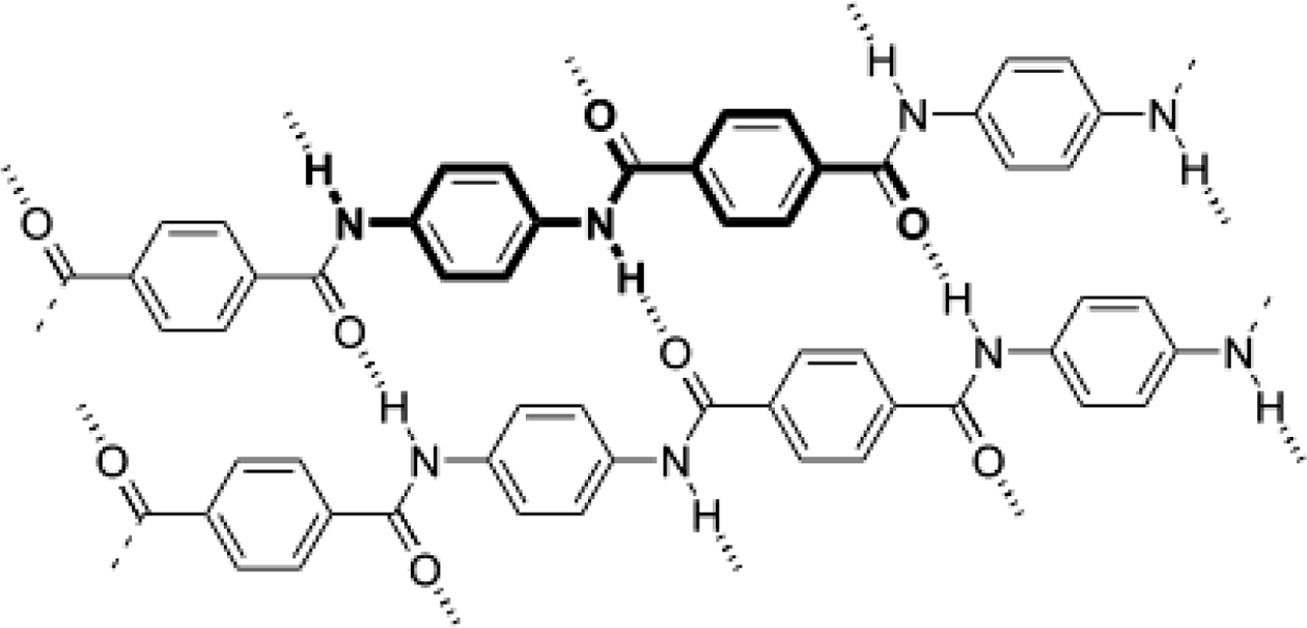
|
Figure 1 Chemical structure of Kevlar. |
Specimen Preparation.
The Kevlar 49 fiber, a bi-directional oriented (0o and 90o) 400GSM, and epoxy resin CT/E-120 and CT/AH-60 were used for preparing plain Kevlar composites using the hand lay-up technique. SMA in the form of wire and sheet is used for developing SMA reinforced Kevlar composites. Four specimens were prepared in the size 300 mm×300 mm by hand lay-up method and the rule of the mixture with the ratio of 50:50 by the percentage of resin to that of reinforcement by weight. The stacking sequence of the specimens is shown in Figure 2. The specimens with different configurations like Kevlar/Kevlar/Kevlar; Kevlar/SMA wire/Kevlar, and Kevlar/SMA sheet/Kevlar were formed by stacking Kevlar fabric of thickness 1 mm as three layers for plain Kevlar composite; and adding SMA in wire form of diameter 1 mm as additional reinforcement between the two Kevlar fabrics at an interval of 9 mm for SMA wire reinforced Kevlar composites, and by adding SMA in sheet form, placed in between the two Kevlar fabric for SMA sheets reinforced Kevlar composites. The samples were fabricated using the hand lay-up method by stacking composites in sequence with epoxy resin and hardener mixed in the ration 10:1 to form the composites.
Tensile Test.
The tensile test was carried out in the Instron 3382 testing machine as per ASTM D-3039 standard. During the tensile test, the specimen was clamped at the ends by a specimen holder and the test was carried out at a speed of 5 mm/min. The different reinforcement for the tensile test is shown in Figure 3. The results of the tensile test are shown in Table 1.
Flexural Test. The flexural strength of the sandwiched composite samples was evaluated using the Instron 3382 testing machine using a three-point bend test setup as per ASTM D-790 Standard. Five specimens were tested for each sample and the average value was tabulated. The different reinforcement for the flexural test is shown in Figure 4. To get a better surface finish at the edges abrasive water jet machine was employed to cut the specimens. The results of the flexural test are shown in Table 1.
The flexural strength is calculated using the formula32

σ: flexural strength, f: force, l: length between the supports, b: specimen width, d: specimen thickness
Low-Velocity Impact Test.
The impact test was carried out in the CEAST Fractovis drop weight impact tower. It employs a hemispherical striker of size 25 mm diameters and weight 1.926 kg. The specimen was held in a circular enclosure of diameter 79 mm clamped with a 50 N force to avoid lateral movement of the specimen. The impact test was conducted on different Kevlar specimens at different velocities 2.8, 3.96, and 4.85 m/sec. The impact force, impact energy, deformation, the time during the impact, and rebounding were recorded using a data acquisition system. For this purpose, an inbuilt piezoelectric sensor inside the striker was used for recording the energy absorbed and the force generated during impact. A standard ASTM D5628-D standard was used for testing the specimens. The top and bottom surfaces of the specimen post-impact tests are shown in Figure 5.
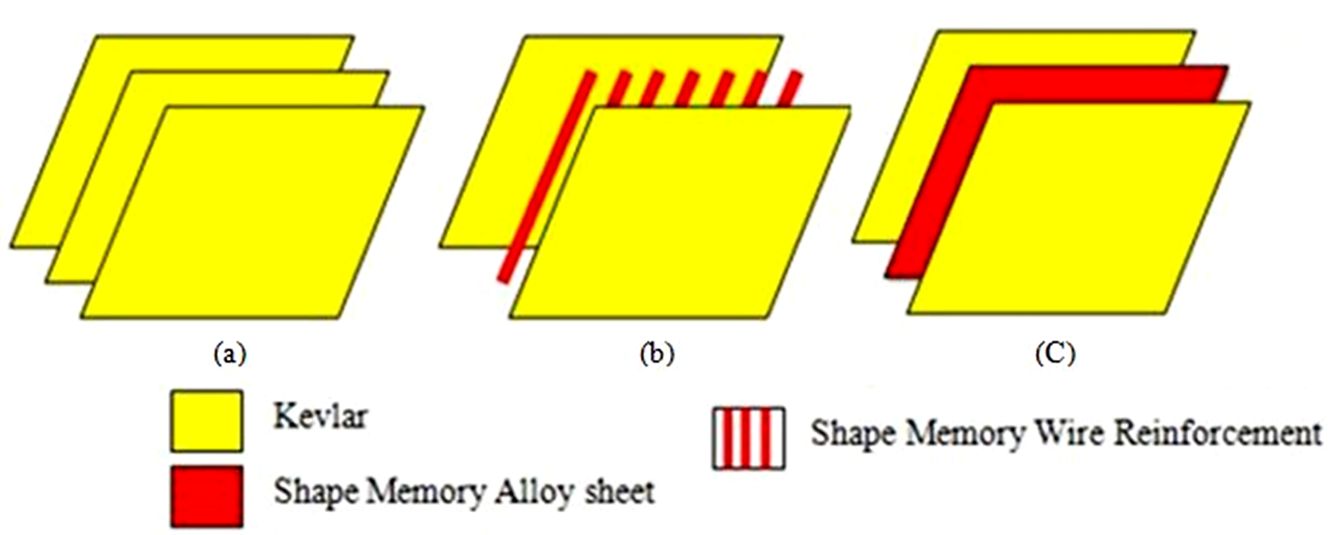
|
Figure 2 Stacking sequence of different forms of reinforcement (a)
[Kevlar/Kevlar/Kevlar]; (b) [Kevlar/SMA wire/Kevlar]; (c) [Kevlar/
SMA sheet/Kevlar]. |
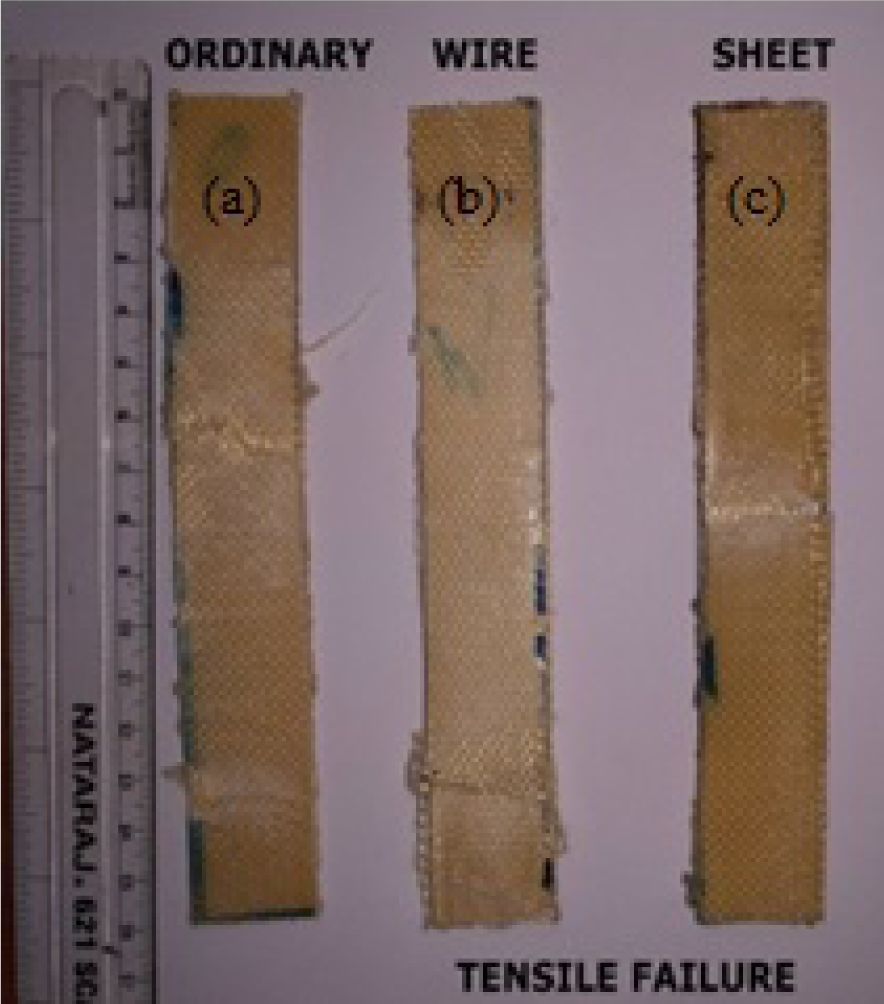
|
Figure 3 Tensile test specimens after testing (a) [Kevlar/Kevlar/
Kevlar]; (b) [Kevlar/SMA wire/Kevlar]; (c) [Kevlar/SMA sheet/
Kevlar]. |
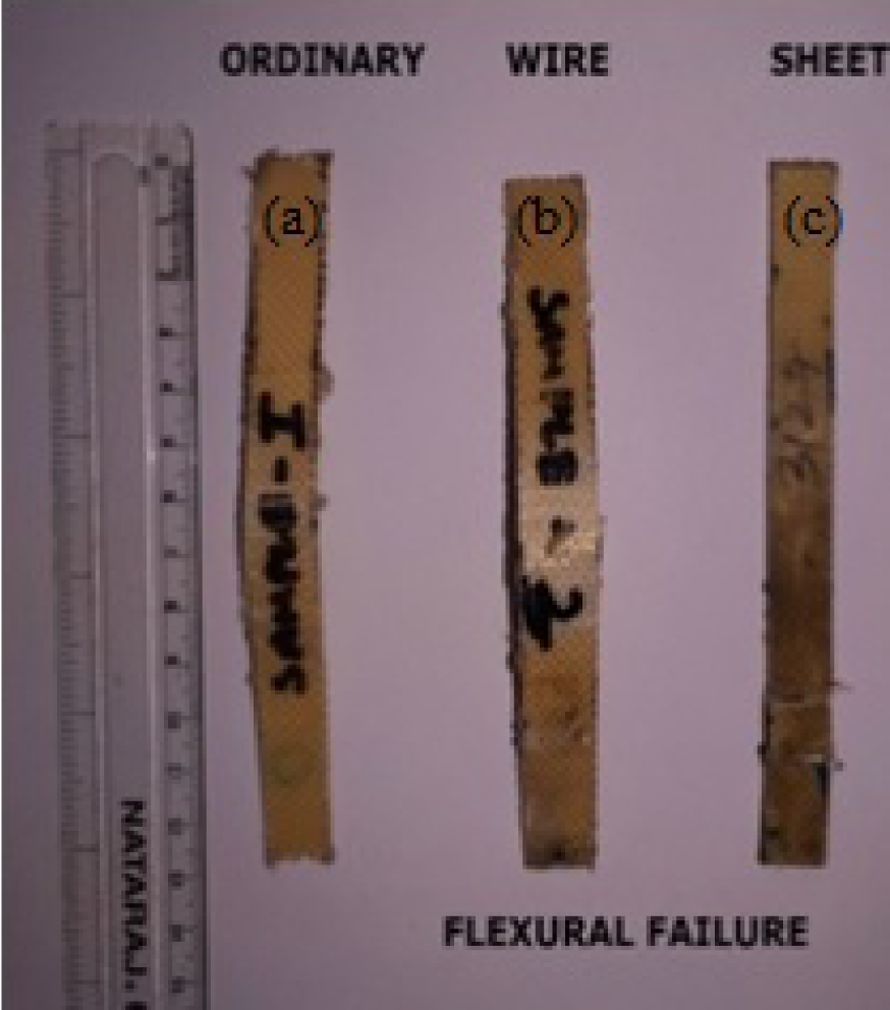
|
Figure 4 Flexural test specimens after impact (a) [Kevlar/Kevlar/
Kevlar]; (b) [Kevlar/SMA wire/Kevlar]; (c) [Kevlar/SMA sheet/
Kevlar] |
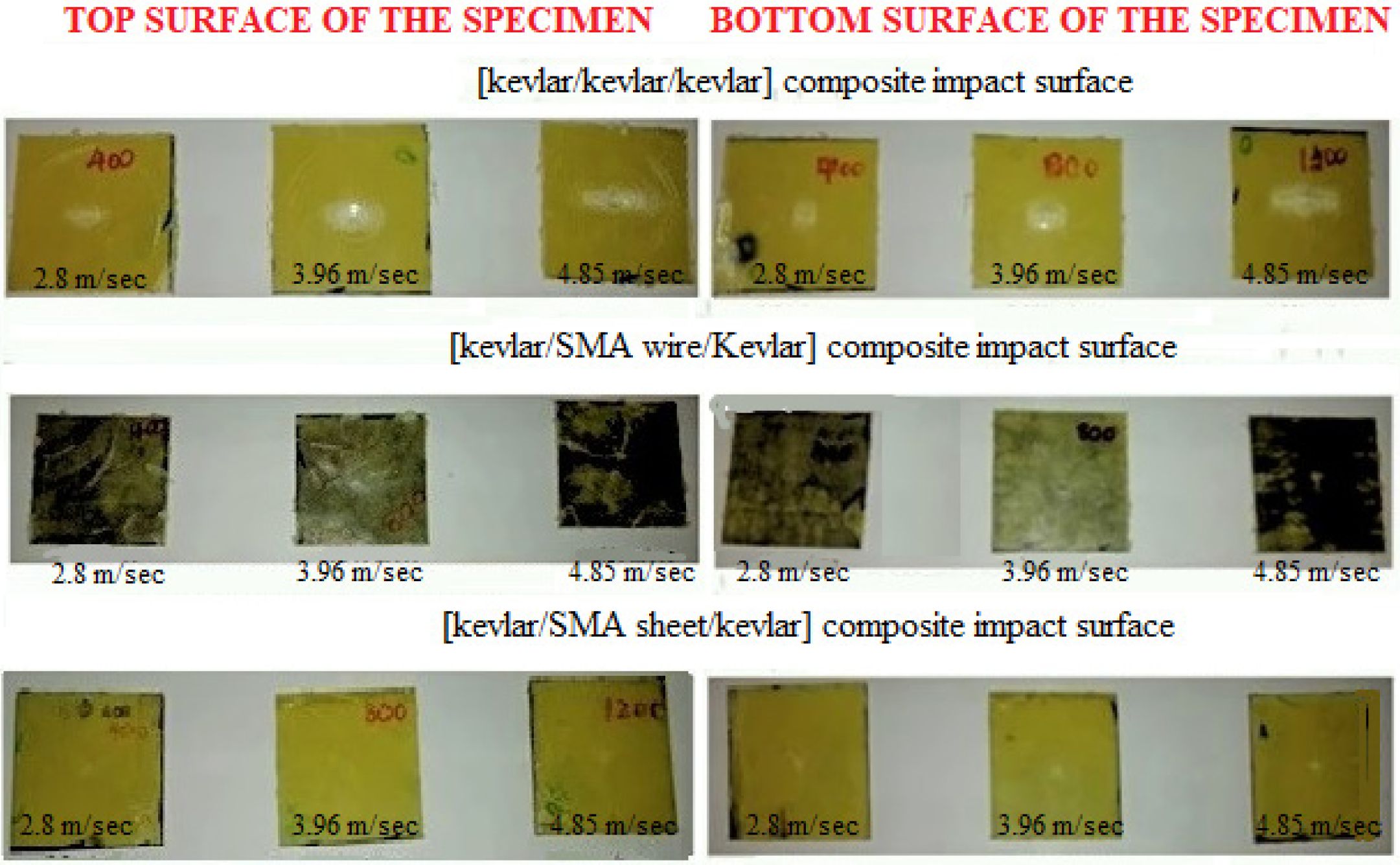
|
Figure 5 Low-velocity impact at bottom and top surface of the reinforced composites. |
Tensile Test. The tensile and flexural test was carried out and the following readings obtained during testing are discussed below. The density of the composite is calculated using the formula below.

Where, ρa: density of the matrix a, ρb: density of the reinforcement b, Va: volume of the matrix a, Vb: volume of the reinforcement b
From Table 1, we can observe that [Kevlar/Kevlar/Kevlar] composite stacking sequence has better tensile strength 196.10 MPa compared to [Kevlar/SMA wire/Kevlar] and [Kevlar/SMA sheet/Kevlar] composite. The high tensile strength in the composite is due to the uniform stacking sequence of Kevlar fabric and increased adhesion observed between epoxy resin matrix and Kevlar fabric as reinforcement. The [Kevlar/SMA sheet/Kevlar] and [Kevlar/SMA wire/Kevlar] composite specimens have lower tensile strength compared to [Kevlar/Kevlar/Kevlar] composite specimen because of poor adhesion between the epoxy resin matrix and SMA sheet & wire reinforcement. Also, the deformation behavior of the specimen during testing is shown in Figure 6. The [Kevlar/SMA sheet/Kevlar] and [Kevlar/SMA wire/Kevlar] failure mode observed during the tensile test was delamination across the cross-section of impact. In [Kevlar/Kevlar/Kevlar] composite failure is observed as matrix cracking along with fiber cracking.
Flexural Test. Flexural strength is considered an important mechanical property of any composite, as, it is related to the bending strength of the material. During the flexural test, a combination of tensile stress acts on the specimen’s outermost top surface of the composite, and compressive stress will act on the bottom surface of the composite specimen. The minimum flexural strength was observed for [Kevlar/SMA wire/Kevlar] composite specimen 116.49 N. The replacement of the middle Kevlar layer with the SMA sheet layer as reinforcement increased the flexural strength from 130.97 to 285.30 N, which is higher than [Kevlar/Kevlar/foam]s as stated by Samlal et al..32 The increase in flexural strength of [Kevlar/SMA sheet/Kevlar] as the fracture toughness of nickel-titanium alloy [SMA] is high33 around 6.45 gm/cm3. The failure mode observed in [Kevlar/Kevlar/Kevlar] and [Kevlar/SMA wire/Kevlar] composite was indentation, micro buckling at the top surface of the epoxy matrix. Also, core shear was observed at the bottom surface of the [Kevlar/Kevlar/Kevlar] composite, similarly observed.32 The failure mode observed in [Kevlar/SMA sheet/Kevlar] composite was buckling at the center of the specimen and matrix cracking. The deformation behavior post flexural test is depicted in Figure 7.
Low-Velocity Impact Test. Impact Force vs. Time:
The impact force or impact resistance offered by the material during the drop weight impact during different velocities is presented in Table 3. The tests were carried out on [Kevlar/Kevlar/Kevlar], [Kevlar/SMA wire/Kevlar], [Kevlar/SMA sheet/Kevlar] and the force was recorded using a data acquisition system. From Figure 8, it is very clear that an SMA sheet reinforced Kevlar polymer composites generated a huge amount of force compared to [Kevlar/Kevlar/Kevlar] and [Kevlar/SMA wire/Kevlar]. Also, a single peak force around 3361, 5951, 7850 N was generated for SMA sheet reinforced polymer composite at different impact speeds, and the impact force was absorbed within a short period compared to other specimens.
Impact Force vs Deformation: The graph depicts the relation obtained between impact forces generated during the impact of the drop hammer weight when it comes in contact with the specimen. It is very clear from Figure 9 that in all the three impact velocities 2.80, 3.96 and 4.85 m/sec the [Kevlar/SMA sheet/Kevlar] composite has generated high force compared to [Kevlar/Kevlar/Kevlar] and [Kevlar/SMA wire/Kevlar] composites. Also, we can observe that the [Kevlar/SMA sheet/Kevlar] composite has a very narrow area below the peak force, which shows that the deformation of the material was very less or negligible. Also, for all the [Kevlar/Kevlar/Kevlar], [Kevlar/SMA wire/Kevlar] and [Kevlar/SMA sheet/Kevlar] composites the indenter penetration was not visible. The closed hysteresis curve also depicts that the amount of energy released back after impact during unloading and the deformation observed in the [Kevlar/SMA sheet/Kevlar] composite was 20.69, 27.43, 37.90% less than [Kevlar/SMA wire/Kevlar] composite and 22.64, 32.97, 44.09% less than [Kevlar/Kevlar/Kevlar] composite for 2.80, 3.96, and 4.85 m/sec impact velocities respectively inferred from Table 4.
Absorbed Energy vs. Deformation: The relation between the energy and deformation rates between different specimens is depicted in Figure 10. The plain Kevlar polymer composite has the highest energy peak 7.65, 15.12, 22.97 J, and SMA sheet reinforced polymer composite has the lowest energy 7.04, 14.66, 22.69 J. It is observed that [Kevlar/SMA sheet/Kevlar] composite has maximum energy absorption 102.56, 147.04, 324.31% higher than [Kevlar/Kevlar/Kevlar] composite and 22.65, 32.97, 44.09% less deformation compared to [Kevlar/Kevlar/Kevlar] composite for 2.80, 3.96, and 4.85 m/sec impact velocities respectively. Also, a steep energy peak is observed for [Kevlar/SMA sheet/Kevlar] could be observed from Figure 10, which depicts better impact resistance compared to [Kevlar/SMA wire/Kevlar] and [Kevlar/SMA sheet/Kevlar] composites.
Impact Area Analysis: The impact surface area analyzed using Image J software is shown in Figure 11. The impact areas of the composite specimens after the drop hammer impact test were calculated and the average reading is tabulated in Table 5.
The impact area was analyzed using Image J Software, developed by the National Institute of Health, University of Wisconsin. The obtained impact area of the composite specimens was grouped for each impact velocity and the different forms of Kelvar reinforcement were ranked from the lowest impact area to the highest impact area as shown in Table 5. For all the impact velocities the [Kevlar/SMA sheet/Kevlar] has shown less impact area compared to the [Kevlar/Kevlar/Kevlar] composite. The decrease in impact area in [Kevlar/SMA sheet/Kevlar] composite is due to an increase in core density, 107.14% compared to [Kevlar/Kevlar/Kevlar] composite as depicted in Table 5.
Surface Morphology: After the impact tests, the Kevlar specimen surface was analyzed and the following observations were made. For all the specimens tested under different impinging velocity, perforation and zero penetration were observed. For [Kevlar/SMA wire/Kevlar] composite matrix cracking was observed and the damaged area was 35% high compared to [Kevlar/Kevlar/Kevlar] composite. For the [Kevlar/SMA sheet/Kevlar] composite, the damaged area was almost negligible, and very few matrix cracks were observed at the top surface. At the bottom surface, no crack was observed for the SMA sheet reinforced Kevlar specimen. For [Kevlar/Kevlar/Kevlar] composite matrix cracking and fiber cracking were observed in Figure 12. The matrix reinforcement composite fracture was studied using a scanning electron microscope and from Figure 12, we can infer that resin has undergone inter crystalline fracture which represents the brittle nature of epoxy resin also observed by Luz et al.34 Also, from Figure 12 we can see a river-like stretched mark, which reveals the direction in which the failure occurred in the matrix, and also represents the brittle fracture in epoxy resin similarly observed by Filho et al.35
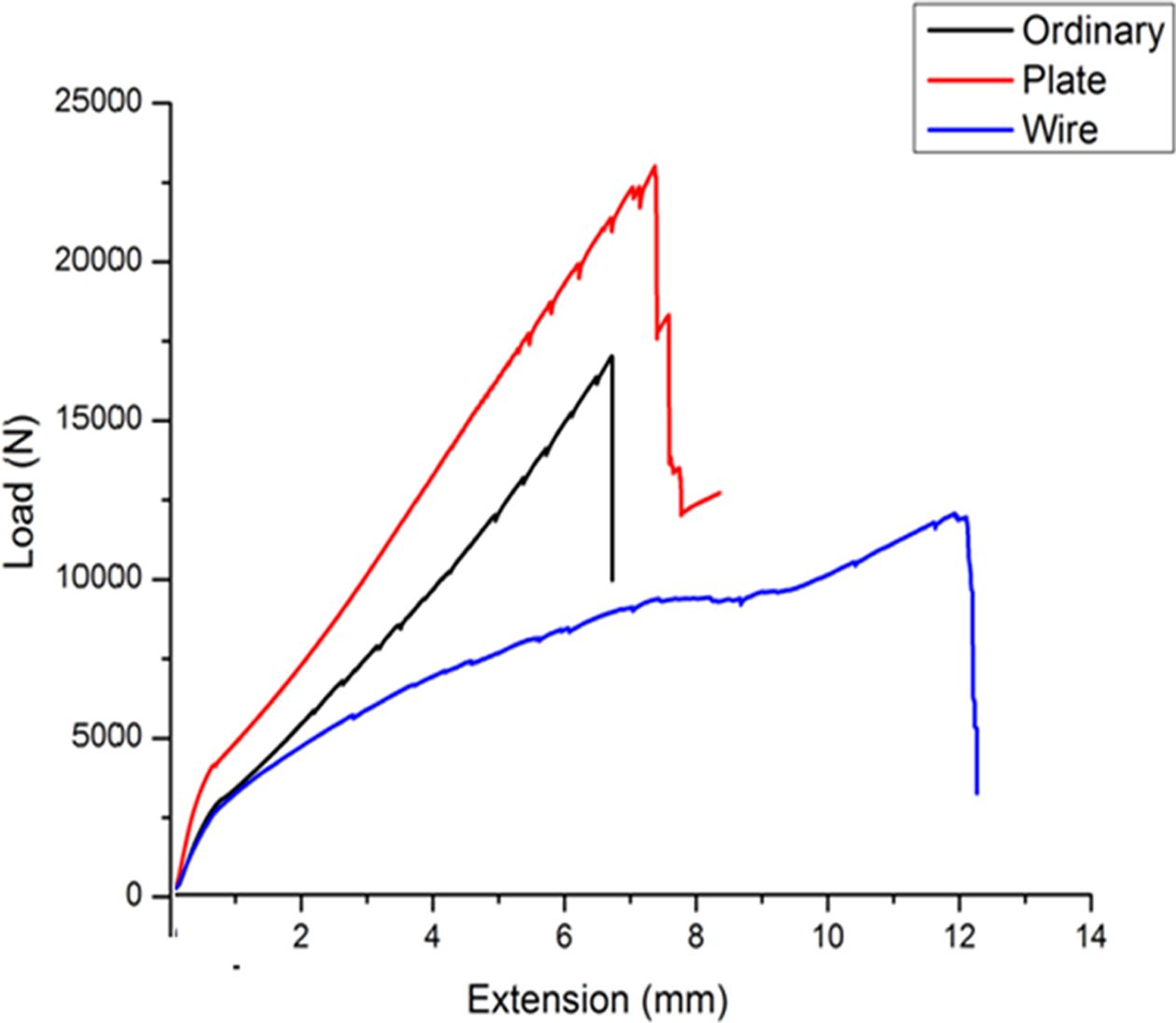
|
Figure 6 Tensile strength vs deformation of the reinforced composites |
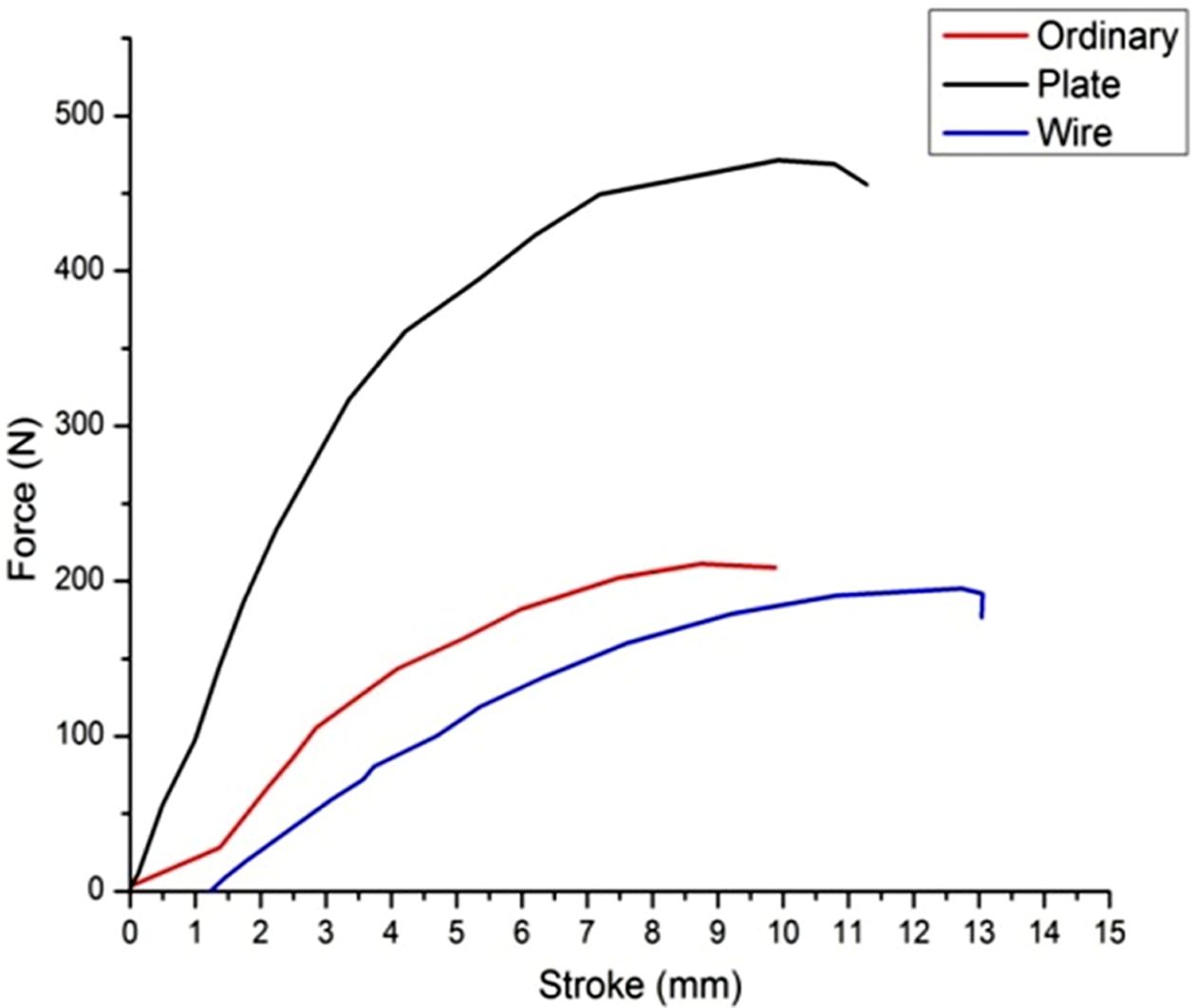
|
Figure 7 Flexural strength vs. deformation of the reinforced composites. |

|
Figure 8 Impact force vs time interaction of the reinforced composites. |

|
Figure 9 Impact force vs. deformation interaction of the reinforced composites |

|
Figure 10 Absorbed energy vs. deformation of the reinforced composites. |
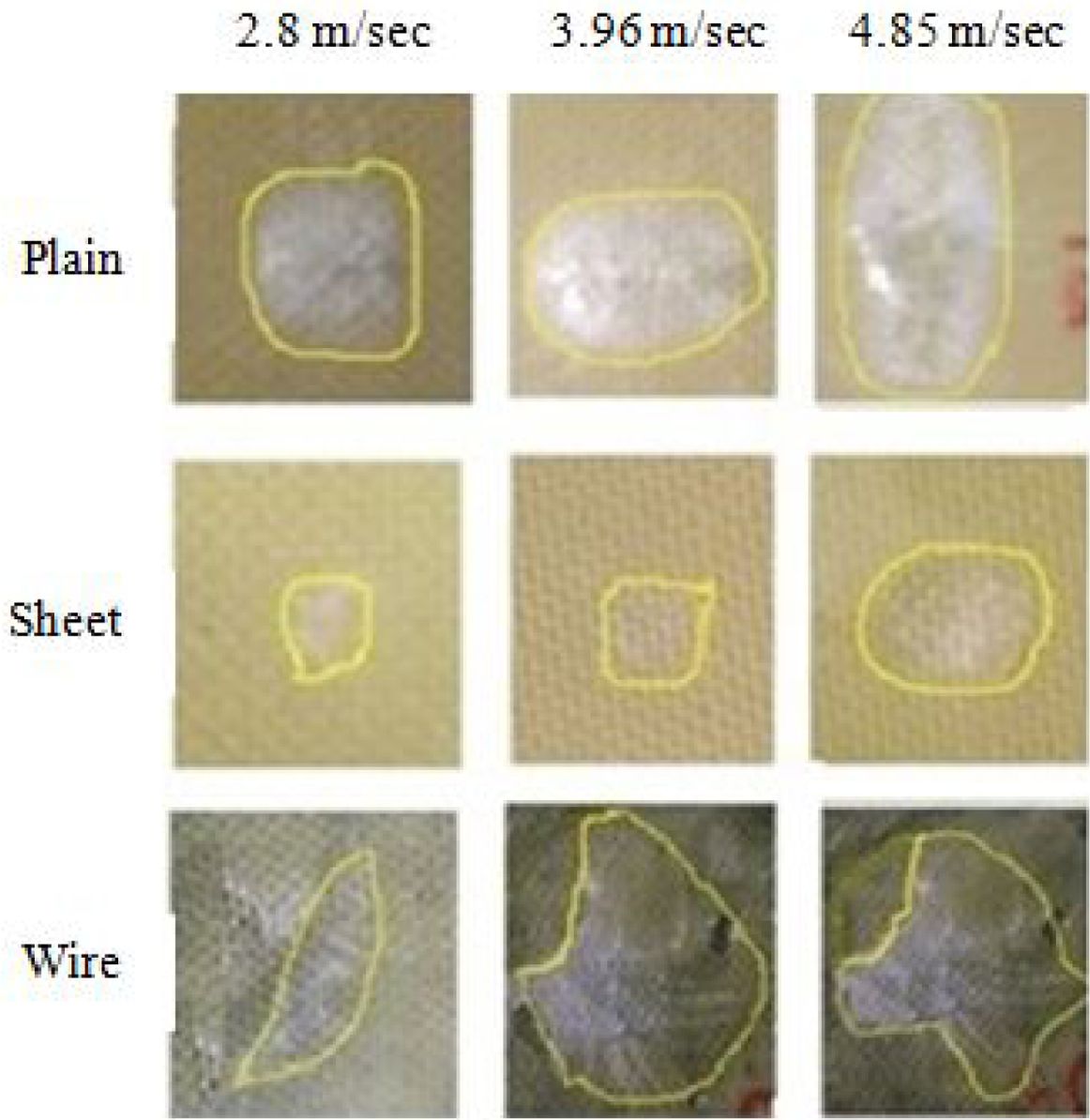
|
Figure 11 Impact area analysis using image J software of the reinforced composites. |

|
Figure 12 Mechanisms of failure in specimens of the reinforced composites. |
The following observations which were observed during the current research are discussed below.
· The addition of SMA in the form of sheet has reduced the deformation by 20.69, 27.43, 37.90% and increased the absorbed energy by 102.56, 147.04, 324.31% in comparison to plain Kevlar epoxy polymer composites at impact velocities 2.80, 3.96, and 4.85 m/sec for low velocity impact test.
· Also, the decrease in the impact area and high absorbed energy peak force indicates increased impact resistance of the [Kevlar/SMA sheet/Kevlar] composite.
· The tensile strength is reduced in SMA Sheet reinforced Kevlar epoxy composite by 30.52% compared to the plain Kevlar epoxy composite due to improper adhesion between the SMA sheet and the Kevlar fabric.
· The SMA sheet reinforced Kevlar epoxy composite has flexural strength 117.84% higher than the plain Kevlar epoxy composite.
· The SMA wire reinforced Kevlar polymer composite has low tensile, flexural strength in comparison to SMA sheet reinforced Kevlar polymer composite and plain Kevlar reinforced polymer composite.
· The reinforcement in SMA wire form reduced the deformation by 2.47, 7.63, 9.96% and increased the impact area by 35% in comparison to [Kevlar/Kevlar/Kevlar] composite at impact velocities 2.80, 3.96, and 4.85 m/sec.
· The SMA sheet reinforced Kevlar epoxy polymer composite has shown superior impact resistance properties with less deformation, and high energy absorption compared to SMA wire reinforced Kevlar epoxy polymer composite and plain Kevlar reinforced epoxy polymer composites.
· The hysteresis curve obtained from the low-velocity impact test revealed that there is little or no penetration in the for all the composite specimens [Kevlar/Kevlar/Kevlar], [Kevlar/SMA wire/Kevlar], and [Kevlar/SMA sheet/Kevlar] composite.
· The failure mode observed during the tensile test, flexural test, and impact test for Kevlar epoxy polymer composite was dominated by fiber cracking and matrix cracking.
· The failure mode observed during the tensile test, flexural test, and impact test for SMA wire and sheet reinforced Kevlar epoxy polymer composites was delamination and matrix cracking on the surface.
· The mechanism of failure majorly observed in the matrix was river-like flow failure stretch marks and intercrystalline fracture.
From the results obtained we can conclude that [Kevlar/SMA sheet/Kevlar] composite has better flexural and superior impact resistance property suitable for automobile structural applications. The [Kevlar/Kevlar/Kevlar] composite has better tensile properties in comparison to SMA wire and Sheet reinforced composites. Further, the research could be carried out on analyzing the bonding strength of matrix and reinforcement to improve the mechanical property of the SMA wire and sheet reinforced Kevlar epoxy polymer composites.
- 1. Maharana, S. M.; Samal, P.; Dehury, J.; Mohanty, P. P. Effect of Fiber Content and Orientation on Mechanical Properties of Epoxy Composites Reinforced with Jute and Kevlar. Mater. Today-Proc. 2020, 26, 273-277.
-

- 2. Bandaru, A. K.; Mittal, V. K.; Ahmad, S.; Bhatnagar, N. Influence of Hybridization on In-plane Shear Properties of 2D & 3D Hybrid Thermoplastic Composites Reinforced with Kevlar/basalt Fabrics. Polym. Test. 2017, 61, 396-403.
-

- 3. Valenca, S. L.; Griza, S.; Oliveira, V. G.; Sussuchi, E. M.; Cunha, F. G. C. Evaluation of the Mechanical Behavior of Epoxy Composite Reinforced with Kevlar Plain Fabric and Glass/kevlar Hybrid Fabric. Composites: Part B 2014, 70, 1-8.
-

- 4. Singh, T. J.; Samanta, S. Characterization of Kevlar Fiber and Its Composites: A Review. Mater. Today-Proc. 2015, 2, 1381-1387.
-

- 5. Lee, M.; Kim, Y.; Ryu, H.; Baeck, S. H.; Shim, S. E. Effects of Silane Coupling Agent on the Mechanical and Thermal Properties of Silica/Polypropylene Composites. Polym. Korea 2017, 41, 599-609.
-

- 6. Park, C.; Kim, B. K. Mechanical Properties of Short Aramid fiber Reinforced Natural and Synthetic Rubber Composites. Polym. Korea 1990, 14, 197-202.
- 7. Fan, Y.; Zhang, H.; Wu, G.; Zhang, H. Dynamic Rheological Behavior.; Processability and Mechanical Properties of PVC/Butyl Acrylate-grafted-Methyl Methacrylate/Styrene Blends. Polym. Korea 2015, 39, 852-859.
-

- 8. Jho, J. Y.; Yee, A. F. Tensile Deformation Behavior of the Copolymers and Blends of Polycarbonate. Polym. Korea 1995, 19, 194-206.
- 9. Park, C. Y; Kim, B. K. Short Aramid Fiber Reinforced Chloroprene Rubber Composite: Effects of Fiber loading and Matrix strength on Physical Properties of the Composite. Polym. Korea 1989, 13, 882-887.
- 10. Ar Shad, Z.; Nasir, M. A.; Baig, Y., Zeehsan, M.; Malik, R. A.; Shaker, K; Hussain, A.; Latif, M.; Sattar, M.; Alrobei, H. Drop Weight Impact and Tension-Tension Loading Fatigue Behaviour of Jute/Carbon Fibers Reinforced Epoxy-based Hybrid Composites. Polym. Korea 2020, 44, 610-617.
-

- 11. Audibert, C.; Andreani, A.; Laine, E.; Grandidier, J.-C. Mechanical Characterization and Damage Mechanism of a New Flax-kevlar Hybrid/epoxy Composite. Compos. Struct. 2018, 195, 126-135.
-

- 12. Lee, J. R.; Kim, J. H.; Shin, D. K.; Kim, B. K. Change of the Flexural Properties of the Carbon/Epoxy Laminates in Pressurized Hot – Wet environment. Polym. Korea 1989, 13, 629-637.
- 13. Joo, H.; Son, J. The Impact Fracture Behaviors of Low Density 2-D Carbon/Carbon Composites by Drop Weight Impact Test. Polym. Korea 2002, 26, 270-278.
- 14. Naik, S.; Dandagwhal, R. D.; Loharkar, P. K. A Review on Various Aspects of 14. Kevlar Composites Used in Ballistic Applications. Mater. Today-Proc. 2020, 21, 1366-1374.
-

- 15. Monteiro, N. S.; Milanezi, L. T.; Louro, L. L. H.; Lima, P. E.; Braga, O. F.; Gomes, V. A.; Drelich, W. J. Novel Ballistic Ramie Fabric Composite Competing with Kevlar Fabric in Multilayered Armor. Mater. Des. 2016, 96, 263-269.
-

- 16. Bandaru, A. K.; Ahmad, S.; Bhatnagar, N. Ballistic Impact Performance of Hybrid Thermoplastic Composite Armors Reinforced with 2D/3D Kevlar and Basalt Fabrics. Composites: Part A 2016, 97, 151-165.
-

- 17. Bandaru, A. K.; Chavan, V. V.; Ahmad, S.; Alagirusamy, R.; Bhatnagar, N. Ballistic Impact Response of Kevlar Reinforced Thermoplastic Composite Armors. Int. J. Impact Eng. 2015, 89, 1-13.
-

- 18. Khodadadi, A.; Liaghat, G.; Bahramian, A. R.; Ahmadi, H.; Anani, Y.; Asemani, S.; Razmkhah, O. High Velocity Impact Behavior of Kevlar/rubber and Kevlar/Epoxy Composites: A Comparative Study. Compos. Struct. 2019, 216, 159-167.
-

- 19. Ismail, F. M; Sultan, T. H. M.; Hamdan, A.; Shah, U. M. A.; Jawaid, M. Low-velocity Impact Behaviour and Post-impact Characteristics of Kenaf/glass Hybrid Composites with Various Weight Ratios. J. Mater. Res. Technol. 2019, 8, 2662-2673.
-

- 20. Bandaru, A. K.; Chavan, V. V.; Ahmad, S.; Alagirusamy, R.; Bhatnagar, N. Low-velocity impact response of 2D and 3D kevlar/polypropylene composites. Int. J. Impact Eng. 2016, 9, 136-143.
-

- 21. Khodadadi, A.; Liaghat, G.; Ahmadi, H.; Bahramian, A. R.; Razmkhah, O. Impact Response of Kevlar/Rubber Composite. Compos. Sci. Technol. 2019, 184, 107880.
-

- 22. Potluri, R.; Paul, K. J.; Babu, B. M. Effect of Silicon Carbide Particles Embedment on the Properties of Kevlar Fiber-reinforced Polymer Composites. Materi. Today-Proc. 2018, 5, 6098-6108.
-

- 23. Prasad, V. V.; Talupula, S. A Review on Reinforcement of Basalt and Aramid (Kevlar 129) Fibers. Mater. Today-Proc. 2018, 5, 5993-5998.
-

- 24. Ramadhan, A. A.; Talib, A. R. A.; MohdRafie, A. S.; Zahari, R. High Velocity Impact Response of Kevlar-29/Epoxy and 6061-T6 Aluminum Laminated Panels. Mater. Des. 2013, 43, 307-321.
-

- 25. Shi, S.; Sun, Z.; Hu, X.; Chen, H. Carbon-fiber and Aluminum-honeycomb Sandwich Composites with and Without Kevlar-fiber Interfacial Toughening. Composites Part A 2014, 67, 102-110.
-

- 26. Kang, T. J.; Kim, C. Energy-absorption Mechanisms in Kevlar Multiaxial Warp-knit Fabric Composites Under Impact Loading. Compos. Sci. Technol. 2000, 60, 773-784.
-

- 27. Rajan, B. M. C.; Kumar, A. S.; Kumar, T. S.; Kumaar, A. S. Impact Response and Damage Characteristics of Carbon Fiber Reinforced Aluminium Laminates (CARAL) under Low-velocity Impact Tests. Mater. Today-Proc. 2018, 5, 20070-20077.
-

- 28. Rahman, A. S.; Mathur, V.; Asmatulu, R. Effect of Nanoclay and Graphene Inclusions on the Low-Velocity Impact Resistance of Kevlar-Epoxy Laminated Composites. Mater. Des. 2014, 187, 481-488.
-

- 29. Sharma, P. A; Khan, H. S.; Velmurugan, R. Effect of Through Thickness Separation of Fiber Orientation on Low-velocity Impact Response Of Thin Composite Laminates. Heliyon 2019, 5, e02706.
-

- 30. Carrillo, J. G..; Gonzalez-Canche, N. G.; Flores-Johnson, E. A.; Cortes, P. Low-velocity Impact Response of Fiber Metal Laminates Based on Aramid Fiber Reinforced Polypropylene. Compos. Struct. 2019, 220, 708-716.
-

- 31. Hu, Y.; Liu, W.; Shi, Y. Low-velocity Impact Damage Research on CFRPs with Kevlar-fiber Toughening. Compos. Struct. 2019, 216, 127-141.
-

- 32. Samlal, S.; Santhanakrishnan, R.; Paulson, V.; Goyal, C. Flexural Property Evaluation of Foam Core Sandwich Panel with Carbon/Kevlar Epoxy Hybrid Facesheets. Mater. Today-Proc., in press.
-

- 33. Hanawa, T. 1-Overview of Metals and Applications. In Metals for Biomedical Devices; Niinomi, M., Ed.; Woodhead Publishing Sevies in Biomaterials; Woodhead Publishing: Cambridge, UK, 2010; pp 3-24.
- 34. Luz, F. S.; Lima, E. P.; Monteiro, S. Ballistic Test of Multilayered Armor with Intermediate Epoxy Composite Reinforced with Jute Fabric. Mater. Res. 2015, 18(Suppl.2), 170-177.
-

- 35. Filho, F. D.; Oliveira, M. S.; Pereira, A. C.; Nascimento, L. F.; Matheus, J. R. G.; Monteiro, S. N. Ballistic Behavior of Epoxy Matrix Composites Reinforced with Piassava Fiber Against High Energy Ammunition. J. Mater. Res. Technol. 2019, 9, 1734-1741.
-

- Polymer(Korea) 폴리머
- Frequency : Bimonthly(odd)
ISSN 0379-153X(Print)
ISSN 2234-8077(Online)
Abbr. Polym. Korea - 2023 Impact Factor : 0.4
- Indexed in SCIE
 This Article
This Article
-
2021; 45(3): 353-362
Published online May 25, 2021
- 10.7317/pk.2021.45.3.353
- Received on Oct 14, 2020
- Revised on Dec 8, 2020
- Accepted on Dec 31, 2020
 Services
Services
- Full Text PDF
- Abstract
- ToC
- Acknowledgements
Introduction
Experimental
Results and Discussion
Conclusions
- References
Shared
 Correspondence to
Correspondence to
- R. Prabu
-
School of Maritime Studies, Vels Institute of Science, Technology & Advanced Studies, 603103, India
- E-mail: rprabu.smts@velsuniv.ac.in
- ORCID:
0000-0001-5305-7463










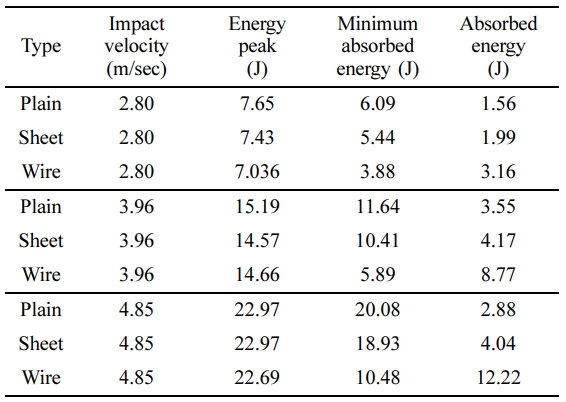
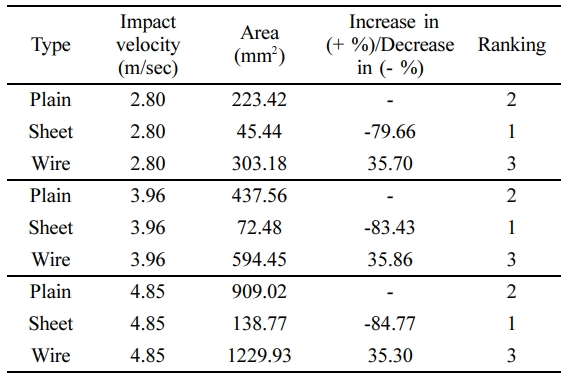
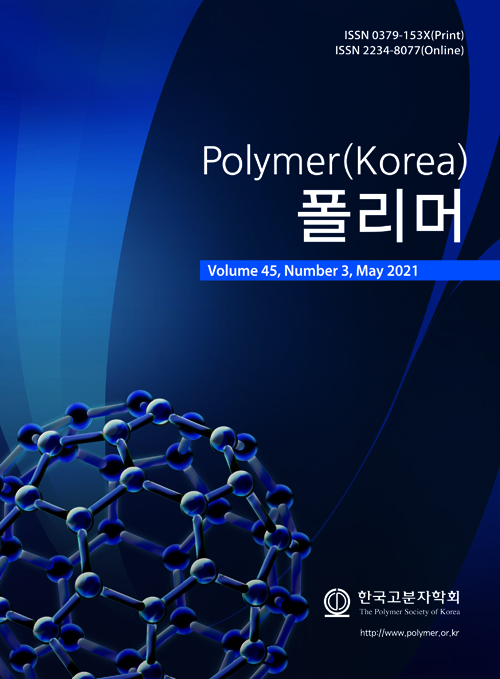
 Copyright(c) The Polymer Society of Korea. All right reserved.
Copyright(c) The Polymer Society of Korea. All right reserved.